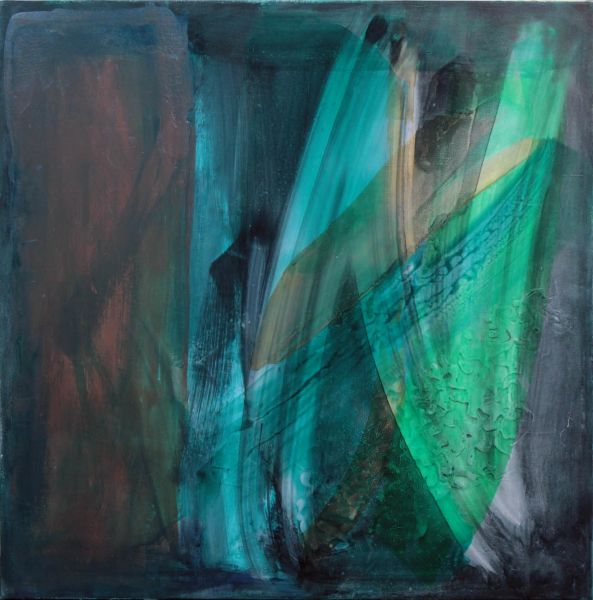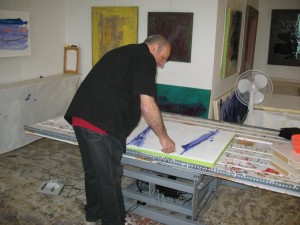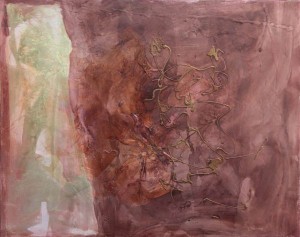ART: Medium inspires message in Giuseppe Albi abstracts
 As soon as you come through the door of the Peter Robertson Gallery, a big, lustrous, luminous abstract painting jumps off the canvas as though backlit. Broad strokes of blue and green glide across the surface adjacent to a vertical bar that first appears to be a deep rose – but then, it magically changes colour. Subtle textures in the paint itself create a three-dimensional effect, almost like a sculpture in acrylic gel. The image above does not even begin to do it justice.
As soon as you come through the door of the Peter Robertson Gallery, a big, lustrous, luminous abstract painting jumps off the canvas as though backlit. Broad strokes of blue and green glide across the surface adjacent to a vertical bar that first appears to be a deep rose – but then, it magically changes colour. Subtle textures in the paint itself create a three-dimensional effect, almost like a sculpture in acrylic gel. The image above does not even begin to do it justice.
What’s going on here is less alchemy than chemistry.
The exhibition of 24 “New Paintings” by Giuseppe Albi, up until March 12, demonstrates the Edmonton abstract artist’s remarkable colour sense and visual acuity. He challenges sensibilities by using colour combinations one might not consider in good taste – a field of orange strokes beside a purple bar, for instance – but the textures he manages using special gels somehow make the clashing hues come together in perfect harmony. Albi’s work is like a sunrise: disparate colours and shapes that glow and contrast across a background.
“I’m focused on making things that are beautiful,” he says. “I like to think of them as uplifting.”
For Albi, how he achieves his striking results is almost as important as why he does it. Don’t even ask, “What does it mean?”
 A visit to the artist’s studio includes a demonstration of the custom-built, servo-motorized table that raises, lowers, tilts, and maybe even makes a cup of coffee. The table is the heart of his workspace and it here that Albi lays canvas down and applies acrylic gels to such great effect. And it is with the gels that the second “chemistry” component enters into his painting. Albi loves to talk about painting, and he can also provide a history of acrylic gel that enabled artists such as Jackson Pollock to create the Abstract Expressionist movement in New York in the ‘40s. Such history is important to him, because he traces those beginnings right through to the materials he uses today.
A visit to the artist’s studio includes a demonstration of the custom-built, servo-motorized table that raises, lowers, tilts, and maybe even makes a cup of coffee. The table is the heart of his workspace and it here that Albi lays canvas down and applies acrylic gels to such great effect. And it is with the gels that the second “chemistry” component enters into his painting. Albi loves to talk about painting, and he can also provide a history of acrylic gel that enabled artists such as Jackson Pollock to create the Abstract Expressionist movement in New York in the ‘40s. Such history is important to him, because he traces those beginnings right through to the materials he uses today.
“Acrylic paint was started in the ‘30s,” he explains. “All they had was red, green, white and black – and it was used for commercial purposes. Then Sam Golden and Lenny Bocour started mixing paints. Artists wanted thick, thick textured surfaces and they developed heavy gels.”
 Painters who were to gain international popularity, gathered at the Golden Acrylic Paints shop in Manhattan, discussing and requesting materials. Albi has continued that practice – albeit, long-distance, using the services of Golden’s custom lab. Jugs of “Golden” line his studio shelves, as part of his long-standing relationship with what has become the doyen of acrylic gels in the world of fine art. They fulfill his requests for what he calls “travel pigment,” sometimes used as a final highlight on the surface to create a colour shift. Different pigment mixtures produce different shifts, depending on the viewing angle.
Painters who were to gain international popularity, gathered at the Golden Acrylic Paints shop in Manhattan, discussing and requesting materials. Albi has continued that practice – albeit, long-distance, using the services of Golden’s custom lab. Jugs of “Golden” line his studio shelves, as part of his long-standing relationship with what has become the doyen of acrylic gels in the world of fine art. They fulfill his requests for what he calls “travel pigment,” sometimes used as a final highlight on the surface to create a colour shift. Different pigment mixtures produce different shifts, depending on the viewing angle.
And so the paint itself, the medium, has inspired Albi to produce the current body of work: “This series shows new colour, new colour combinations, new textures, which is generated by the new paint,” he says. “All of this is really characteristic of abstract painters. The paintings are divided into two sections and there are distinct looks to each section. There’s a colour shift, as well as the paint application and the texture. It really affords me the opportunity to pour, brush and stain.”
Albi has had a lot more time to paint recently. He’s just retired from a full-time position as head of Events Edmonton that produces the Taste of Edmonton and First Night festivals. Previously, he would paint in the morning before work, and on weekends. Now he can do it all the time.
“The biggest thing is to have the time to be able to go back into a painting as it dries and manipulate it as it dries,” he says. “Now, I can go back into it and work it.”
The results are obvious on the canvases in one of the best shows of the Edmonton’s spring season, if not the entire year.












